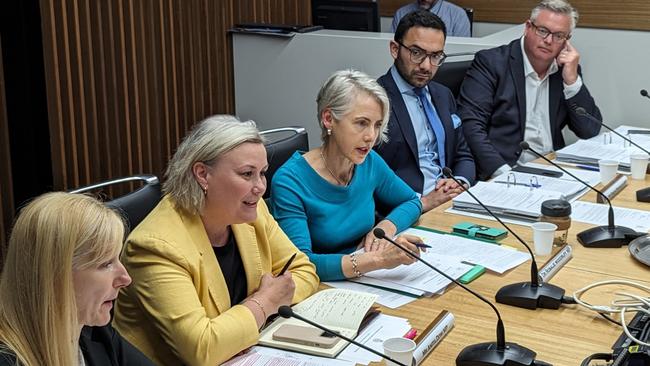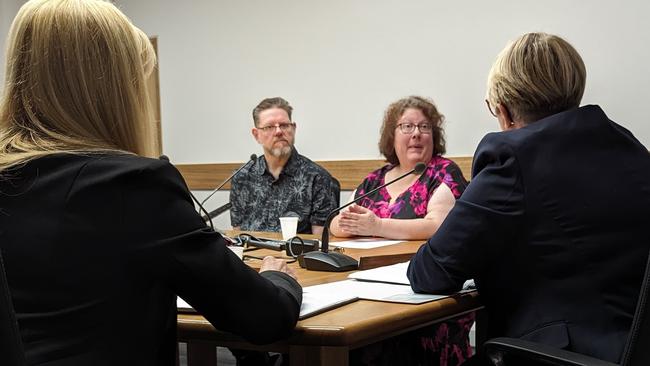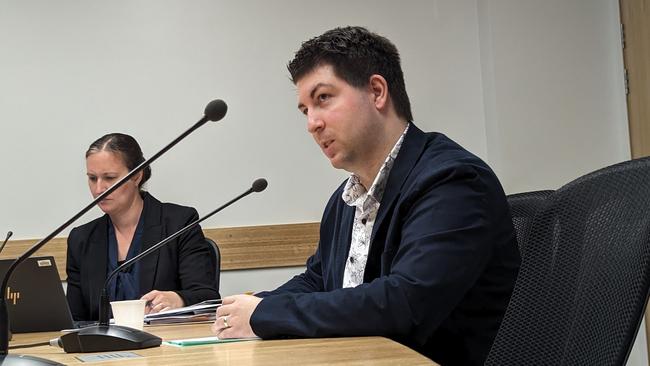Tasmania ramping inquiry: How Launceston’s Stella Jennings found out about mum’s ramping death
Tasmania’s ramping inquiry has heard harrowing evidence from the daughter of a woman who died while ramped at the LGH. She shared how she gradually found out something had gone horribly wrong. Latest from the inquiry.

Tasmania
Don't miss out on the headlines from Tasmania. Followed categories will be added to My News.
Tasmania’s ramping inquiry has heard harrowing evidence from the daughter of a 71-year-old woman who died while ramped at the Launceston General Hospital for eight hours.
Day one of public hearings of the Select Committee on Transfer of Care Delays (Ambulance Ramping) commenced in Launceston on Wednesday, with Stella Jennings, supported by her husband Joe, sharing her traumatic experience with the LGH.
Ms Jennings’ mum Anne Helen Pedler died on August 6 last year of lung blood clots and deep vein thrombosis.
In August, Coroner Robert Webster found Ms Pedler, who suffered a cardiac arrest at about 8.30am while still waiting for admission to the emergency department nearly eight hours after her arrival, received “substandard” care from the LGH.
Mr Webster found the on-call pathologist had not received a follow-up call about the urgent pathology request for Ms Pedler and was thus not alerted until several hours later.
Ms Jennings told the committee she wanted her mum’s death to be “a catalyst for change so other families don’t have to go through what we had to”.

Ms Jennings said when she was contacted by the hospital on August 6 to inform her that her mother had died, she was told, “we did all we could, nothing more could have been done.”
“I left the hospital devastated but not realising something was amiss,” she said.
Approximately two weeks later she was contacted by the hospital to say there would be a root cause analysis into Ms Pedler’s death – which came as a shock.
At a meeting to discuss the results of the analysis, she said executives pinned her mum’s death “mainly [on] the missed phone call”.
“They didn’t make a lot of critical issues transparent to us. It wasn’t until the coroners report some months later the breadth of failures that led to mum’s death [became apparent],” Ms Jennings said.
“We were hoping they’d tell us what was wrong but I think they told us the parts they wished to tell us.
“It’s a bit more devastating because you come away from the meeting thinking there was a small error on their behalf, you put that to bed in your head a little bit, but then months later you get the coroners report and realise it was nowhere near the truth.
“They’re not going to tell you we’ve contributed majorly to your mother’s death.”
The executives also stressed at the initial meeting their “dual-care model” when patients are ramped, wherein both hospital staff and paramedics care for those awaiting admission.
“How can that be efficient or best possible practice?” Ms Jennings asked.
It was only at a subsequent meeting, in the wake of the coroners report, that it was “acknowledged there were broad systemic issues” and that the missed follow-up call was only a small contributor.
Ms Jennings said she had been advocating for the Department of Health to install 24-hour pathology and radiology services at LGH but feels as though her requests have fallen on deaf ears.
“The pace of change is so incredibly slow it appears to not be moving at all,” she said.
Ms Jennings, who works in disability support and has a young family, said the thought of her NDIS clients, or children, having to use the LGH in future “makes me sick”.
“I worry they just aren’t going to get the care,” she said.
Having moved to Launceston from Melbourne four years ago, Ms Jennings said she “just didn’t realise the health system comparatively is in such bad repair.”
“So many things are falling through the cracks.”
A Department of Health spokesman said that seven of eight recommendations made from the root cause analysis had been enacted, with progress “nearing completion” on the eighth.
“These include how to improve the process to request urgent diagnostic testing, and increased education of staff to ensure greater awareness of the requirements for escalating patient cases,” he said.
The select committee’s public hearings continue in Hobart on Thursday.
Tasmania’s 13 district hospitals grossly under-utilised, ramping inquiry hears
The president of the Rural Doctors Association of Tasmania has told the parliament’s ramping inquiry that there are 150 rural hospital beds – more than the whole of Mersey Community Hospital – yet they only have an occupancy rate of approximately 50 per cent.
Dr Ben Dodds, who provides doctor services to Scottsdale’s North Eastern Soldiers Memorial Hospital, said there is a “whole hospital worth” of beds across 13 rural communities, but that the hospitals continued to suffer “degradation” of services and workforce.
With the number of rural and remote Tasmanians requiring emergency and inpatient services at the state’s four public hospitals rising by 20 to 30 per cent in recent years, better utilising the district hospitals is a key plank of reducing bed block, Dr Dodds said.

However, a roadblock exists in that the four major hospitals sit within Tasmanian Health Service’s acute sector, while the district hospitals are within the primary health sector, and the “two sides aren’t always talking to each other,” Dr Dodds said.
Furthermore, the “majority” of doctors servicing the district hospitals have been “outsourced,” Dr Dodds, who is an employee of Ochre Health, said.
“If doctors want to effect change in their local community there is a significant barrier because they are not an employee of THS,” he said.
He cited the example of Queensland Health as a way it could be done better – where there is a “market failure” and regional doctors cannot be sourced by the private sector, government accepts the responsibility, taking over the service and employing a doctor across the district hospital and private GP clinic.
Queensland Health then receives a portion of the Medicare rebates generated by the service to defray costs.
Dr Dodds said there needed to be a comprehensive audit of Tasmania’s 13 district hospitals to discover what services they offered, what skills their workforce possessed, and what equipment they operate, as the district hospitals had grown higgledy-piggledy with little direction from the top.





